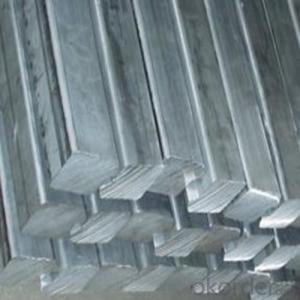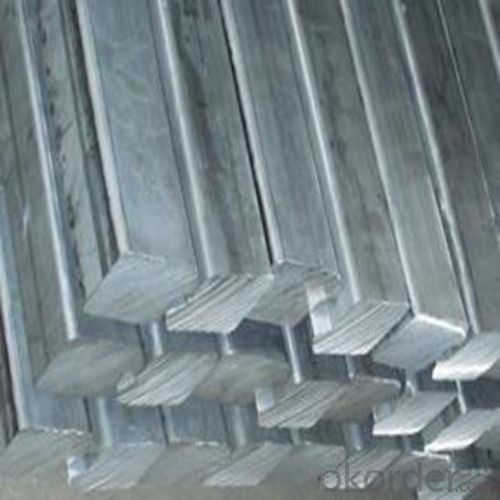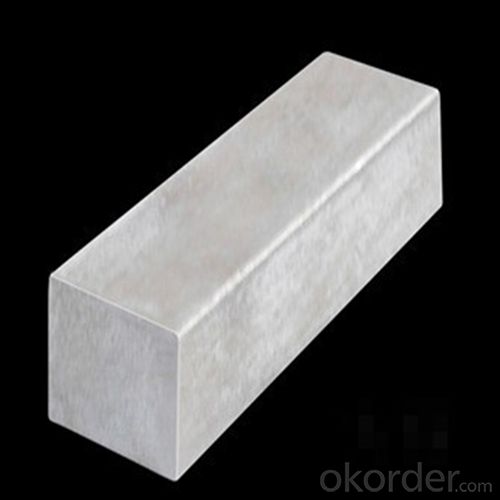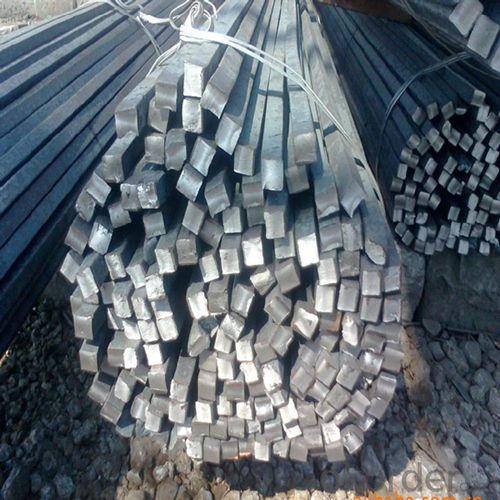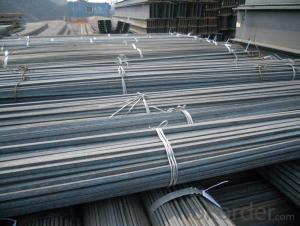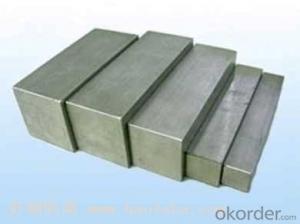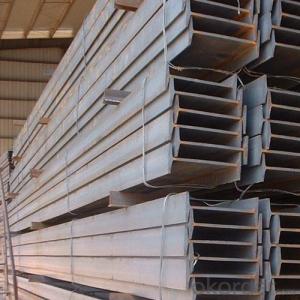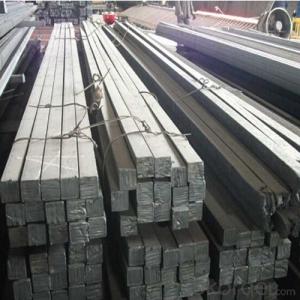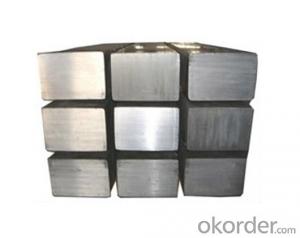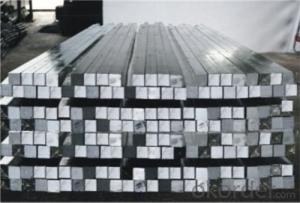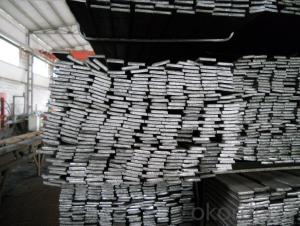Structure Steel of Square Long Bar of 6 Meters and 12 Meters
- Loading Port:
- Tianjin
- Payment Terms:
- TT or LC
- Min Order Qty:
- 25 m.t.
- Supply Capability:
- 10000 m.t./month
OKorder Service Pledge
OKorder Financial Service
You Might Also Like
1. Structure of Structure Steel of Square Long Bar Description:
Structure steel of square long bar is a bar with square shaped cross-section. It is special case of equal sides. Before steel products are sold on the market, the steel must first be processed into more functional pieces. Raw steel cannot be of use while in its pure form, thus it has to be cast into shape. The freshly made steel, structure steel of square long bar is still in the form of a metal bar or rectangle. Small sizes of Structure steel of square long bar are used in ship building.
2. Main Features of Structure Steel of Square Long Bar:
• Grade: Q235
• Type: Mild carbon steel
• A quadrilateral with four equal sides and four right angles.
• Vibration: The stiffness and mass are chosen to prevent unacceptable vibrations, particularly in settings sensitive to vibrations, such as offices and libraries.
• Local yield: Caused by concentrated loads, such as at the beam's point of support.
3. Structure Steel of Square Long Bar Images:

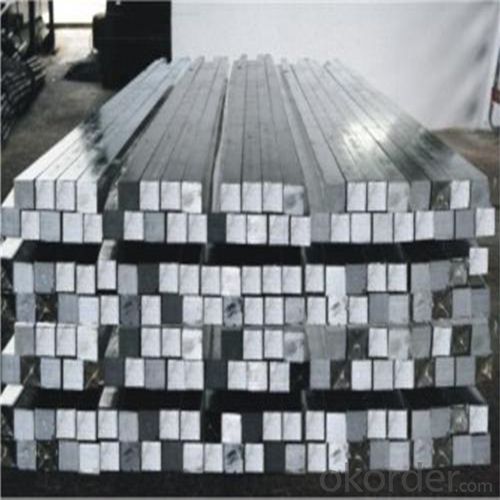
4. Structure Steel of Square Long Bar Specification:
Mechanical Properties | Grade | Steel diameter(mm) | |||
≤16 | 16~40 | 40~60 | 60~100 | ||
Yield Point Δs/MPa | Q195 | ≥195 | ≥185 | - | - |
Q235 | 235 | 225 | 215 | 205 | |
Tensile Strength | Q195 | 315~390 | |||
Q235 | 375~500 | ||||
Elongation δ5% | Q195 | ≥33 | ≥32 | - | - |
Q235 | 26 | 25 | 24 | 23 | |
5. FAQ
We have organized several common questions for our clients,may help you sincerely:
①What is the main material?
There are two types of Square Bar, one is hot rolled square bar and other one is cold drawn square bar. Our principal products is hot rolled square bar. We dedicate to products with material Q195 and Q235. We offer products with high quality and low price.
②How to inspect the quality?
We have a professional inspection group which belongs to our company. We resolutely put an end to unqualified products flowing into the market. At the same time, we will provide necessary follow-up service assurance.
③Is there any advantage about this kind of product?
Steel I beam bar IPE has a reduced capacity in the transverse direction, and is also inefficient in carrying torsion, for which hollow structural sections are often preferred.
- Q: Can a steel square be used for checking the flatness of a ceiling?
- No, a steel square is not typically used for checking the flatness of a ceiling. A level or a straightedge would be more appropriate tools for this task.
- Q: How do you use a steel square to lay out a hexagon?
- To use a steel square to lay out a hexagon, you would start by aligning the long edge of the square with the edge of your material. Then, using the 90-degree angle of the square, mark two points along the edge of the material. Next, rotate the square 60 degrees and mark two more points, making sure they align with the previous marks. Finally, rotate the square another 60 degrees and mark the remaining two points. Connect all the marked points, and you will have successfully laid out a hexagon using a steel square.
- Q: How do you use a steel square to mark out 75-degree angles?
- To mark out 75-degree angles using a steel square, the following steps are typically followed: 1. Ensure that the long side of the square is parallel to the edge where the angle will be marked, and place it on a flat surface or workpiece. 2. Align one edge of the square with the desired starting point of the angle, which will serve as the reference line for marking. 3. Locate the line on the steel square that represents a 45-degree angle, usually marked with a number or symbol. 4. Starting from the reference line, count inwards along the 45-degree angle line in the direction of the desired angle. In this case, measure 30 degrees inward along the 45-degree line. 5. Once the appropriate distance is measured, make a mark at that point, indicating the starting point of the 75-degree angle. 6. From the starting point, measure an additional 75 degrees in the desired direction, using the appropriate scale on the steel square. This can be the 90-degree line or a specific angle scale marked on the square. 7. Make a second mark at the endpoint of the 75-degree angle, completing the marking process. Remember to verify your measurements and use a sharp pencil or marker for accurate and visible markings. It is also advisable to practice using the steel square on scrap material before marking the final workpiece to ensure precision.
- Q: Are steel squares available in different sizes?
- Yes, steel squares are available in different sizes. Steel squares, also known as engineers' squares or try squares, are typically available in various sizes to cater to different needs and applications. They come in different lengths, commonly ranging from 3 inches to 12 inches or more. The size of a steel square refers to the length of its blade or beam, which is the part used for measuring or marking. The size of a steel square is chosen based on the specific requirements of the task at hand, such as the dimensions of the workpiece or the level of precision desired.
- Q: How do you use a steel square to measure and mark irregular angles?
- To use a steel square to measure and mark irregular angles, you need to follow a few steps. First, position the steel square against the angle you want to measure, making sure one edge of the square aligns with one side of the angle. Next, tighten the square against the angle by holding it firmly in place. Once the square is secure, look at the markings on the square's body. These markings typically include degrees or angles, allowing you to accurately measure the angle you are working with. Align the appropriate marking on the square with the other side of the angle, and take note of the measurement. To mark the irregular angle, you can use a pencil or a scribe tool. Hold the square against the angle, aligning the desired measurement with the other side of the angle. With the square in place, use the pencil or scribe tool to mark the angle on the material you are working with. Be sure to hold the square steady while marking to ensure accuracy. If the angle you are working with is particularly complex or irregular, you may need to use additional tools or techniques to accurately measure and mark it. In such cases, consulting a professional or referring to specific resources for measuring irregular angles can be helpful.
- Q: Can a steel square be used for trellis layout and construction?
- Yes, a steel square can be used for trellis layout and construction. The steel square, also known as a framing square, is a versatile tool commonly used in carpentry and construction. It can be used to measure and mark angles, lay out straight lines, and create precise right angles, which are all essential for designing and constructing a trellis. The sturdy and durable nature of steel makes it suitable for outdoor use, ensuring the longevity and stability of the trellis structure.
- Q: Can a steel square be used for checking the levelness of floors?
- No, a steel square cannot be used for checking the levelness of floors. A steel square, also known as a carpenter's square, is primarily used for measuring and marking right angles in woodworking. It is not designed to accurately determine the levelness of surfaces. To check the levelness of floors, a tool such as a spirit level or laser level should be used. These tools are specifically designed for this purpose and provide accurate measurements of horizontal or vertical levelness.
- Q: Can a steel square be used for measuring angles in framing?
- No, a steel square cannot be used for measuring angles in framing. A steel square, also known as a framing square or carpenter's square, is primarily used for making accurate right angle measurements and cuts in carpentry work. It consists of two arms, one longer than the other, forming a 90-degree angle, and usually has a ruler along the longer arm. While it can be used to measure and mark angles up to 45 degrees, it is not designed for precise angle measurements beyond that. For measuring angles in framing, it is recommended to use a protractor or an angle finder tool specifically designed for accurate angle measurements.
- Q: What are the common materials used to make steel squares?
- Steel squares are typically made using a variety of common materials. The main material used to make steel squares is, of course, steel. Steel is a widely used material due to its high strength, durability, and resistance to corrosion. It provides the necessary stability and hardness required for accurate measurements and precise marking. In addition to steel, other materials are also commonly used in the production of steel squares. One such material is brass. Brass is often used for the face of the square, as it is softer and less likely to damage delicate surfaces when used for marking or scribing. Another material that can be found in steel squares is wood. Wooden handles are often attached to steel squares to provide a comfortable grip and ease of use. Wood is chosen for its natural warmth, durability, and ability to absorb vibrations, ensuring a more stable and accurate measurement. Overall, steel squares are typically made using a combination of steel, brass, and wood. These materials work together to create a reliable and versatile tool that is commonly used in various industries such as carpentry, metalworking, and engineering.
- Q: What are some common uses of a steel square in metalworking jewelry making?
- The steel square, also known as the try square or carpenter's square, finds extensive application in metalworking and jewelry making due to its versatility. Here are several common ways in which the steel square is utilized in these fields: 1. Precise measurement and marking: The steel square is frequently employed for accurate measurement and marking of straight lines and right angles. It ensures precise measurements and aids in maintaining symmetry in jewelry making projects. 2. Angle verification: Metalworkers and jewelry makers rely on the steel square to verify if their workpieces possess 90-degree angles. This is essential to ensure proper alignment and fit during various stages of fabrication, such as soldering, welding, or component assembly. 3. Layout and design: Steel squares are indispensable tools for laying out patterns, templates, and designs on metal sheets or bars. They facilitate the transfer of measurements and angles with precision, ensuring consistency and accuracy in the final piece. 4. Squareness verification: The steel square proves useful in verifying the squareness of corners, edges, or joints. This is vital for maintaining the structural integrity and visual appeal of metalwork and jewelry pieces. 5. Scribing and marking arcs: Steel squares often feature markings that enable the scribing of arcs or circles of different sizes. This aspect is particularly beneficial in jewelry making, where curved shapes and designs are frequently encountered. 6. Flatness assessment: Metalworkers and jewelers employ the steel square to assess the flatness of surfaces, ensuring their levelness and uniformity. This is crucial for achieving a professional finish and ensuring proper fitting when joining different metal components. 7. Machinery alignment and setup: Steel squares are frequently used in metalworking workshops to align and set up machinery such as drill presses, milling machines, or lathes. They contribute to accurate positioning, resulting in precise and consistent outcomes. In summary, the steel square is an essential tool in metalworking and jewelry making, providing accuracy, consistency, and efficiency across various tasks, including measurement, marking, layout, and design. Its versatility renders it a vital component of any metalworker or jeweler's toolbox.
Send your message to us
Structure Steel of Square Long Bar of 6 Meters and 12 Meters
- Loading Port:
- Tianjin
- Payment Terms:
- TT or LC
- Min Order Qty:
- 25 m.t.
- Supply Capability:
- 10000 m.t./month
OKorder Service Pledge
OKorder Financial Service
Similar products
Hot products
Hot Searches
Related keywords
